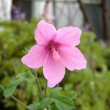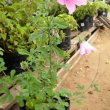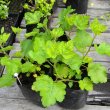| Botanical Name |
|
| Family |
Malvaceae - The hibiscus and cotton family. |
| Pronunciation |
hi-BIS-kus ped-un-kew-LAH-tus |
| Common Name(s) |
Afrikaans: Pienk hibiskus
|
| Plant Group |
- Shrub A woody plant of relatively low height, having several stems arising from the base and lacking a single trunk; a bush.
|
| Plant Size |
- Small to Medium
| Tree | 8m to 15m |
| Shrub | 75cm to 1m |
| Perennial/ground cover | 20cm to 40cm |
| Bulb | 30cm to 40cm |
| Succulent | 20cm to 40cm |
|
| Position |
- Canopy Shade Canopy shade is found below closely grown trees where some light filters through. Ideal for the protection of herbaceous plants.
- Dry Shade Shady areas where soil has poor water retention or are dependent on rain for their moisture needs.
- Light or Dappled Shade Found below trees with sparse, open foliage. Ideal for the protection of herbaceous plants.
- Partial Shade The area is in shade for part of the day and in full sun for part of the day.
- Sun The area is in full sun for all or most of the day, all year round.
|
| General Information |
- Drought Tolerance: Moderate The plant is moderately adapted to arid conditions and can survive short periods of drought and high temperatures without extra water.
- Evergreen to semi-deciduous The plant is evergreen in warmer, wetter parts of the country, but may lose some of its leaves during winter in colder, drier situations.
- Frost: Half-hardy The plant is able to survive low temperatures and some frost but requires protection against severe frost.
- Water Moderate These plants will need some extra watering compared to water-wise plants. Plant them together, in at least some shade and in a convenient proximity to the house so that grey water can be utilised during times of drought.
|
| Specific Information |
Hibiscus pedunculatus is a sparsely branched shrub found along the edges of forest and coastal bush. The lobed leaves, stems, buds and seed capsules are covered in coarse hairs. It is low growing with only the flowering stems growing tall. Flowers last only one day but make a striking show in a hedgerow or shrub border. In the veld around Bathurst I have only found these shrubs growing in the light shade of other plants.
|
| Ad Break |
|
| Flowers |
| Description |
Trumpet- shaped with five broad petals, about 4 cm across
|
| Season |
- All Year Plants will seldom bloom for the entire season as given in the list, but should flower during a period within these parameters.
- Summer to Autumn Plants will seldom bloom for the entire season as given in the list, but should flower during a period within these parameters.
|
| Colour |
|
| Growth Rate |
- Moderate to Fast Specifying growth rate can be very misleading as there is considerable variation of growth rate depending on type and species of plant, available water, supplementary feeding, mulching and general care, as well as the plants suitability and adaptability to the garden environment.
|
| Plant Uses |
- Attracts bees, butterflies or other insects This plant attracts insects which can be food for birds or other creatures in your garden.
- Boundary A plant useful for planting around the edges of the property to form a green or colourful backdrop, an impenetrable hedge, to hide walls or create privacy.
- Filler Either a fast growing tree or shrub used temporarily to fill in an area while the permanent plants grow to a desired size, or a plant used to fill gaps in borders or beds.
- Wild Garden An indigenous garden planted for the benefit of wildlife and birds. Provides food, water, a variety of mini-biomes and no poisonous chemicals are used.
|
| Distribution and Habitat |
in the Eastern Cape, KwaZulu-Natal, Mpumalanga and the Northern Province, along the edges of forests and bush
|
| Planting Suggestions |
Plant Hibiscus pedunculatus in groups close together between other shrubs in a shrub border or on the edges of a hedgerow, where the flowers will peek out, while the woody part of the shrub itself is hidden. This shrub is reasonably fast-growing if it is planted in rich, well-drained garden soil and watered on occasion, especially during summer. For optimum growth add some compost or organic material to the soil and apply a thick layer of mulch. Prune when flowering has halted in autumn, by cutting back the tall woody stems. In frosty areas choose a sheltered position. Too much shade will prevent flowering.
Collect ripe seed when the pods are dry but before they burst open. The seeds germinate readily and are planted in late winter to early spring. Takes easily from stem cuttings taken during late summer.
|
| Medicinal Uses |
No data specific to this species has yet been found.
|
| Ad Break |
|







Discuss this plant
Share knowledge, ask a question or give an experience.